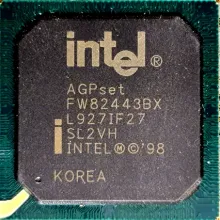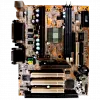
The Intel 440BX (codenamed Seattle), also known as the 82443BX, is a classic and influential chipset introduced by Intel in 1998. It was designed for use with the Intel Pentium II and Pentium III processors and played a significant role in the development of the personal computer industry during the late 1990s.
Key features of the Intel 440BX chipset include support for the Accelerated Graphics Port (AGP) for improved graphics performance, support for PC100 Synchronous Dynamic Random-Access Memory (SDRAM) for faster memory access, and compatibility with the Universal Serial Bus (USB) standard, which was becoming increasingly important for peripherals.
The 440BX chipset was widely used in many high-end desktop and workstation motherboards, and it helped establish the foundation for modern PC architecture by introducing several technologies that are still relevant today.

